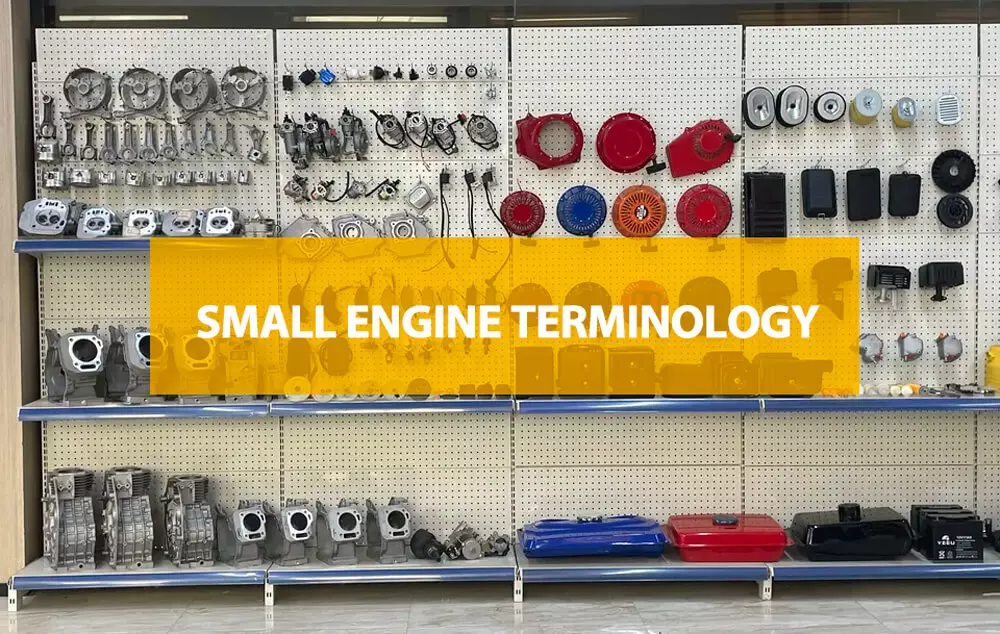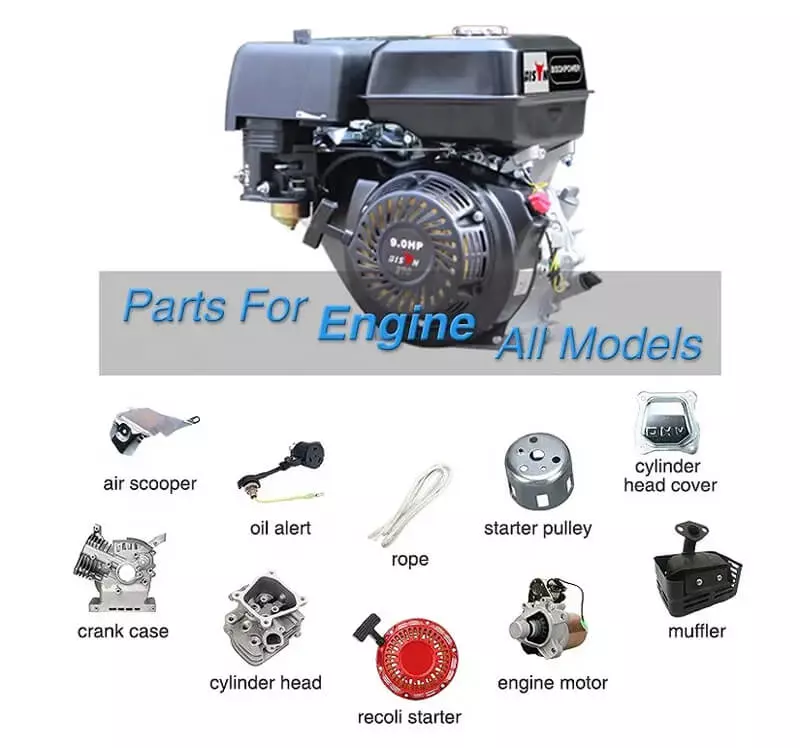small engine terminology
2023-10-17
Table of content
When we talk about "small engines," we're referring to a class of engines typically under 25 horsepower. They are compact, efficient power sources that power all kinds of machines around us. From brush cutter to motorcycles, portable generators to garden tractors, these small engines play an integral role in our daily lives.
Understanding small engine terminology is critical for anyone who uses, purchases, or repairs machines powered by these engines. Becoming familiar with these terms will allow you to better understand how these engines work, diagnose problems, communicate effectively with service professionals, and even perform some minor repairs yourself.
In this article, we'll take a closer look at small engine terminology. BISON breaks down complex terms into easy-to-understand explanations. This glossary will provide a comprehensive guide for both new and experienced enthusiasts.

Types of small engines
Two-stroke engine: This engine completes one power cycle through two strokes of the piston during only one revolution of the crankshaft. In short, it does the entire job in just two steps - intake, compression, combustion and exhaust, which makes it very efficient. You'll often find two-stroke engines in equipment like chain saws and jet skis.
Four-stroke engine: Unlike a two-stroke engine, this engine completes the power cycle through four piston strokes: intake, compression, combustion (power), and exhaust. Essentially, it takes four steps to do what a two-stroke engine can do in just two steps. This reduces fuel consumption and reduces emissions. Four-stroke engines are commonly used in items such as brush cutters and cars.
Diesel engine: Diesel engines use the heat of compressed air to ignite the fuel. They are known for their efficiency and durability. You may find small diesel engines in some types of generators or heavy machinery.
Gasoline engine: Also known as a petrol engine, gasoline engines use spark ignition to burn fuel. The spark from the spark plug ignites the air-fuel mixture in the combustion chamber, driving the piston down and creating power. Small gasoline engines are commonly used in portable power tools and some vehicles.
Overhead valve (OHV) engine: In an OHV engine, the valves are located above the combustion chamber in the cylinder head. This design allows for more direct valve control, resulting in faster valve response times and improved fuel efficiency. OHV engines are widely used in a range of machinery including automobiles and lawn mowers.
Overhead camshaft (OHC) engine: The valves of an OHC engine are also located in the cylinder head, but the camshaft that controls the opening and closing of the valves is also located in the cylinder head rather than in the cylinder block. This design improves engine performance and efficiency at high speeds. OHC engines are commonly found in cars and motorcycles
Common Small Engine Terms
These terms are often used to describe the specifications and performance of an engine. Let's break them down:
Bore: This refers to the diameter of the cylinder in an engine. It's a critical factor that, along with the stroke, determines an engine's displacement.
Compression ratio: This is the ratio of the volume of the combustion chamber when the piston is at the bottom of its stroke to the volume when the piston is at the top of its stroke. A higher compression ratio can lead to greater fuel efficiency and power output but may also require higher-octane fuel.
Displacement: This is the total volume of all the cylinders in an engine, usually measured in cubic centimeters (cc) or liters (L). It's calculated by multiplying the number of cylinders by the area of a cylinder (based on the bore) and the stroke length. Displacement gives an idea of an engine's size and power potential.
Horsepower: This is a unit of measurement used to denote the power an engine produces. One horsepower is equivalent to the power needed to lift 550 pounds one foot in one second. The more horsepower an engine has, the more work it can do over a given time.
Stroke: In the context of engines, a stroke refers to the full travel of the piston along the cylinder, in either direction. The number of strokes in one cycle defines whether an engine is a two-stroke or a four-stroke engine.
Torque: This is the twisting force produced by an engine.
six systems of small engines
Small gas engines consist of individual systems that work together to produce electricity. Every system has several components. Internal combustion engines require six systems: exhaust, fuel, ignition, cooling, combustion, and lubrication.
Exhaust System
Exhaust Manifold: The exhaust manifold collects the exhaust gases from multiple cylinders into one pipe. Its purpose is to funnel the exhaust gases into one central location, the rest of the exhaust system, to be safely expelled.
Tailpipe: The final section of the exhaust system, where it releases the cleaned and muffled exhaust gases into the atmosphere.
Muffler: Reduces noise. Bolted or threaded onto the engine
Fuel System
Fuel Injector: Fuel injectors are a key part of modern engines. They deliver fuel into the engine's cylinders in a precise and atomized manner which is then ignited to drive the engine. The injector needs to deliver the fuel at the right time, in the right amount, and in the right pattern for efficient combustion.
Fuel Pump: The fuel pump's job is to deliver fuel from the tank to the engine. It must supply the fuel under high pressure (for fuel injection systems) or low pressure (for carburetor systems), so that the fuel arrives at the injectors or carburetor in a consistent and smooth manner.
Fuel line: The line through which fuel is transferred from the tank to the carburetor.
Fuel tank: This is where the engine's fuel is stored. The size of the fuel tank often determines how long the engine can run before needing a refill. It's designed to feed fuel to the carburetor.
Ignition System
Battery: Stores electrical energy until it is needed to power devices.
Stator: The stator is a crucial component in the ignition system of small engines. It's part of the alternator and works with the rotor to generate electricity. The stator coil uses a permanent magnet to produce a magnetic field for a small alternator.
Ignition coil: This component is a crucial part of the engine's ignition system. It transforms the battery's low voltage to the thousands of volts needed to create an electric spark in the spark plugs, igniting the fuel.
Spark plug: The spark plug is responsible for igniting the air-fuel mixture in the engine's combustion chamber. It does this by transmitting electrical energy from the ignition system, which creates a spark.
Recoil starters: Crank the engine at high speed to start the system. Found in products such as chainsaws, lawnmowers, and weed eaters.
Cooling System
Air-cooled engines: An air-cooled engine relies on the circulation of air directly over heat dissipation fins or hot areas of the engine to cool them in order to keep the engine within operating temperatures.
Liquid-cooled engines: A liquid-cooled engine uses a coolant (usually a mixture of water and antifreeze) to transfer heat from the engine to the radiator where the heat is dissipated into the atmosphere.
Fans: Most small engines are air-cooled using fans located outside the combustion chamber.
Flywheel: Sits above the engine. It has a metal cover called the blower housing. Works like a fan. Cool the engine.
Blower housing: Sits around the flywheel. It aims to direct air through the blower housing to cool the engine.
Lubrication System
Oil Pan: The oil pan, also known as the oil sump, is located at the bottom of the engine. It serves as a reservoir for the engine's oil. When your engine is at rest, the oil drains back into the pan where it's collected and stored.
Oil Pump: The oil pump is a critical component of the engine's lubrication system. Its function is to draw oil from the oil pan and pump it throughout the engine to lubricate, cool, and clean the moving parts.
Oil filter: Removes contaminants circulating in the oil.
combustion System
Carburetor: Mixes fuel with air for combustion.
Cylinder block: Each cylinder block must be cast in a mold to achieve its best appearance for proper operation. Inside the cylinder block are all the small engine parts. Its exterior dissipates heat through aluminum alloy fins. The single cylinder is the type found in most small engines. However, other parts of small engines have many cylinders; the most common are inline, opposed, and V configurations.
Cylinder head: Many small engines have a combustion chamber. A head gasket is attached to the top of the cylinder, called the cylinder head. The spark plug is housed in the cylinder head.
Piston: It is made of cast steel or aluminium material. The piston mounts to the connecting rod via a pin and is fastened in place by retaining clips. A piston may have one to three rings. These top rings are used for compression. The bottom ring is known as the oil ring. Only four-stroke engines have oil rings. This ring cannot rotate because a pin inside the ring groove prevents any rotation.
Valves: The valves are made of high-grade steel, and are located on the cylinder block and the seal. The intake valve and exhaust valve create better airflow in the engine. The intake valve is bigger than the exhaust valve.
Air cleaner: Also known as an air filter, this component cleans the air that goes into the engine for the combustion process. It removes dust, pollen, and other airborne particles that could potentially harm the engine. A clean air filter ensures that your engine gets plenty of clean air to mix with the fuel for efficient combustion.
Cylinder: There is an inner wall called a cylinder wall. It fits the piston accurately to the machined diameter. The inner wall is very smooth, allowing the piston and rings to work smoothly.
Connecting rod: The connecting rod joins the crank to the piston. The wrist pin attaches the piston to the wrist pin and is secured by a clip. There may be one or two connecting rods. The bottom is removable on two-piece units.
Head gasket: Between the cylinder and the cylinder head is the head gasket. This gasket seals the cylinder. The function of the head gasket is to keep the pressure inside the combustion chamber. This component must withstand high temperatures.
Crankcase: The crankshaft is the part of the engine that rotates. This part sits inside the crankcase. The crankcase changes the up, down and circular motion of the piston. It has heavy counterweights for balance. It sits at a 90-degree angle on the cylinder.
Camshaft: A camshaft is a key part of an engine that controls the timing of the opening and closing of the valves. It's a rod with multiple lobes (cams) that push against the valves as it rotates, allowing fuel and air into the combustion chamber.
Valve spring: Holds the valves closed, ensuring a tight seal maintains pressure on the camshaft. It prevents the camshaft from floating.
Conclusion
Understanding the small engine terminologies is vital to anyone looking to maintain, repair, or understand the machinery that drives many of our outdoor devices. Whether you're improving efficiency or a homeowner looking to extend the life of your appliances, these insights will undoubtedly prove beneficial.
By staying informed and confident in the language of small engines, you'll keep your equipment in good working conditions.

